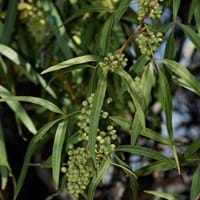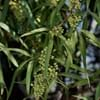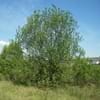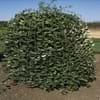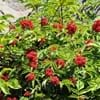Life Span
Not Available
Perennial
Type
Tree
Bulb or Corm or Tuber
Origin
Southern Africa, South Africa
South America
Types
Not Available
Pamianthe cardenasii , Pamianthe parviflora , Pamianthe peruviana
Habitat
Forest margins, Grassland, Mountains, Pastures, Rocky Ridges, Woods
All sorts of environments
USDA Hardiness Zone
8-11
8-10
Sunset Zone
8, 9, 12, 13, 14, 15, 16, 17, 18, 19, 20, 21, 22, 23, 24
21,22
Habit
Spreading
Clump-Forming
Flower Color
Light Green, Ivory
White
Flower Color Modifier
Bicolor
Bicolor
Fruit Color
Yellow, Red
Green
Leaf Color in Spring
Green
Dark Green
Leaf Color in Summer
Dark Green
Light Green
Leaf Color in Fall
Dark Green
Several shades of Green
Leaf Color in Winter
Dark Green
Light Green
Leaf Shape
Lance shaped
Strap shaped
Plant Season
Spring, Summer, Fall, Winter
Spring, Summer, Fall
Sunlight
Full Sun, Partial Sun, Partial shade
Partial Sun, Partial shade
Type of Soil
Loam, Sand
Loam, Sand
The pH of Soil
Neutral, Alkaline
Acidic, Neutral, Alkaline
Soil Drainage
Well drained
Average
Bloom Time
Early Spring
Spring, Late Spring, Early Summer, Summer, Late Summer
Tolerances
Pollution, Drought
Drought
Where to Plant?
Ground
Ground, Pot
How to Plant?
Seedlings, Stem Planting, Transplanting
Offsets
Plant Maintenance
Medium
Medium
Watering Requirements
Form a Soil ring to water efficiently, Use and maintain water-efficient soaker hoses, Use Mulches to help prevent water loss during hot and windy weather, Water Deeply
Keep the ground moist but not water-logged
In Summer
Lots of watering
Lots of watering
In Spring
Moderate
Moderate
In Winter
Average Water
Average Water
Soil pH
Neutral, Alkaline
Acidic, Neutral, Alkaline
Soil Type
Loam, Sand
Loam, Sand
Soil Drainage Capacity
Well drained
Average
Sun Exposure
Full Sun, Partial Sun, Partial shade
Partial Sun, Partial shade
Pruning
Prune if you want to improve plant shape, Remove damaged leaves, Remove dead leaves, Remove dead or diseased plant parts
Pinch or prune as they grow to promote branching and bushiness, Remove damaged leaves, Remove dead branches, Remove dead leaves, Requires little pruning
Fertilizers
All-Purpose Liquid Fertilizer
All-Purpose Liquid Fertilizer, High phosphorus
Pests and Diseases
Red blotch
Leaf spot, Mosaic viruses
Plant Tolerance
Drought
Drought
Flowers
Insignificant
Showy
Flower Petal Number
Single
Single
Foliage Texture
Fine
Coarse
Foliage Sheen
Glossy
Glossy
Attracts
Birds
Bees, Birds, Bumblebees, Butterflies, Hummingbirds, pollinators
Allergy
no allergic reactions
Unknown
Aesthetic Uses
Not Used For Aesthetic Purpose
Beautification, Bouquets, Ornamental use, Showy Purposes
Beauty Benefits
Not Available
No Beauty Benefits
Environmental Uses
Air purification
Air purification
Medicinal Uses
Diarrhea, Dysentry
No Medicinal Use
Part of Plant Used
Flowers, Leaves
Not Available
Other Uses
Culinary use, Employed in herbal medicine, Used as a dye, Used as a spice, Used in paper industry, Wood is used for making furniture
Beneficial species for attracting pollinators, Decoration Purposes
Used As Indoor Plant
No
No
Used As Outdoor Plant
Yes
Yes
Garden Design
Screening / Wind Break, Shade Trees, Street Trees, Topiary / Bonsai / Espalier
Bog Garden, Container, Feature Plant, Foundation, Mixed Border, Water Gardens
Botanical Name
RHUS lancea
HYMENOCALLIS longipetala
Common Name
African Sumac
Peruvian Daffodil, Spiderlily
In Hindi
अफ्रीकी एक प्रकार का पौधा
peruvian daffodil
In German
African sumac
peruvian daffodil
In French
sumac africaine
peruvian daffodil
In Spanish
zumaque africano
Pamianthe
In Greek
Αφρικανική σουμάκι
peruvian daffodil
In Portuguese
sumac africano
peruvian daffodil
In Polish
afrykański sumaka
peruvian daffodil
In Latin
African sumac
peruvian daffodil
Phylum
Not Available
Magnoliophyta
Class
Not Available
Liliopsida
Order
Sapindales
Asparagales
Family
Anacardiaceae
Amaryllidaceae
Clade
Angiosperms, Eudicots, Rosids
Angiosperms, Monocots
Tribe
Not Available
Clinantheae
Subfamily
Anacardioideae
Amaryllidoideae
Number of Species
Not Available
Season and Care of African Sumac and Peruvian Daffodil
Season and care of African Sumac and Peruvian Daffodil is important to know. While considering everything about African Sumac and Peruvian Daffodil Care, growing season is an essential factor. African Sumac season is Spring, Summer, Fall and Winter and Peruvian Daffodil season is Spring, Summer, Fall and Winter. The type of soil for African Sumac is Loam, Sand and for Peruvian Daffodil is Loam, Sand while the PH of soil for African Sumac is Neutral, Alkaline and for Peruvian Daffodil is Acidic, Neutral, Alkaline.
African Sumac and Peruvian Daffodil Physical Information
African Sumac and Peruvian Daffodil physical information is very important for comparison. African Sumac height is 460.00 cm and width 460.00 cm whereas Peruvian Daffodil height is 61.00 cm and width 61.00 cm. The color specification of African Sumac and Peruvian Daffodil are as follows:
African Sumac flower color: Light Green and Ivory
African Sumac leaf color: Green
Peruvian Daffodil flower color: White
- Peruvian Daffodil leaf color: Dark Green
Care of African Sumac and Peruvian Daffodil
Care of African Sumac and Peruvian Daffodil include pruning, fertilizers, watering etc. African Sumac pruning is done Prune if you want to improve plant shape, Remove damaged leaves, Remove dead leaves and Remove dead or diseased plant parts and Peruvian Daffodil pruning is done Pinch or prune as they grow to promote branching and bushiness, Remove damaged leaves, Remove dead branches, Remove dead leaves and Requires little pruning. In summer African Sumac needs Lots of watering and in winter, it needs Average Water. Whereas, in summer Peruvian Daffodil needs Lots of watering and in winter, it needs Average Water.
